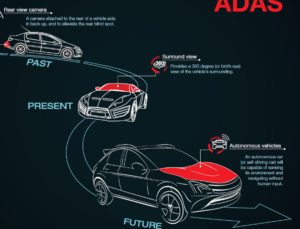|
Getting your Trinity Audio player ready…
|
Advanced Driver Assistance Systems (ADAS) are becoming increasingly popular in modern vehicles, providing drivers with a range of safety features and improved driving experiences. These systems use a combination of sensors, cameras, and software to monitor the vehicle’s surroundings and provide warnings or assistance to the driver in real-time. In this article, we will explore the different types of ADAS available, their benefits, and their potential limitations.

Types of ADAS
ADAS can be divided into four main categories based on their functions. These categories include:
Collision Avoidance Systems
This type of ADAS is designed to help prevent accidents by providing warnings or even taking control of the vehicle to avoid a collision. These systems include Forward Collision Warning (FCW), Automatic Emergency Braking (AEB), and Lane Departure Warning (LDW).

Driver Assistance Systems
These systems are designed to assist the driver in various driving tasks, such as parking, changing lanes, and maintaining a safe distance from other vehicles. Examples of these systems include Adaptive Cruise Control (ACC), Blind Spot Detection (BSD), and Parking Assist.
Vehicle-to-Vehicle (V2V) Communication
This is a new type of ADAS that allows vehicles to communicate with each other, sharing information about their locations, speeds, and other relevant data. This technology has the potential to greatly improve safety on the roads, particularly in situations where visibility is poor.
Pedestrian Detection
This type of ADAS is designed to detect pedestrians and other vulnerable road users, such as cyclists, and provide warnings or take action to help avoid a collision.
Benefits of ADAS
ADAS has a wide range of benefits for both drivers and passengers. These benefits include:
Improved Safety:
ADAS can help prevent accidents by providing warnings or taking control of the vehicle in dangerous situations. This technology can also help reduce the severity of accidents that do occur, potentially saving lives.
Reduced Driver Fatigue:
Driver assistance systems such as Adaptive Cruise Control can help reduce driver fatigue by helping to maintain a safe distance from other vehicles and reducing the need for constant acceleration and braking.
Improved Comfort:
ADAS can provide a more comfortable driving experience by reducing the stress and effort required for certain driving tasks, such as parking or maintaining a safe distance from other vehicles.
Reduced Insurance Costs:
As ADAS becomes more widespread, insurance companies are starting to offer discounts for vehicles equipped with these systems. This is because ADAS has been shown to significantly reduce the risk of accidents, which in turn reduces insurance claims.
Limitations of ADAS
While ADAS has many benefits, there are also some potential limitations to consider. These include:
Reliance on Sensors
ADAS relies heavily on sensors and cameras to gather information about the vehicle’s surroundings. These sensors are not prone to weather conditions such as rain, dirt, or debris on the road, leading to incorrect detection. Similarly, blind-spot monitoring systems may not always detect a vehicle in the driver’s blind spot, potentially leading to an accident.
Complacency in drivers
Second, ADAS technology can create a false sense of security for drivers. When drivers rely too heavily on these systems, they may become complacent and fail to remain vigilant while driving. This can lead to dangerous situations, particularly if the ADAS technology fails.
Not able to detect unpredictable events
Current ADAS technology is limited by its ability to detect and respond to unpredictable events. For example, sudden changes in road conditions, such as construction zones or large potholes, may be missed by the sensors or cameras in ADAS technology. This means that drivers must remain alert and ready to take control of the vehicle at any time.
Conclusion
Advanced driver assistance systems have the potential to greatly improve road safety and reduce the number of accidents caused by human error. With the rapid development of technology, these systems are becoming increasingly sophisticated and ubiquitous. However, there are still challenges to look into in terms of ensuring their reliability and effectiveness. As we move towards a future of autonomous vehicles, it is important to continue investing in research and development of these systems to ensure that they are safe and reliable.
